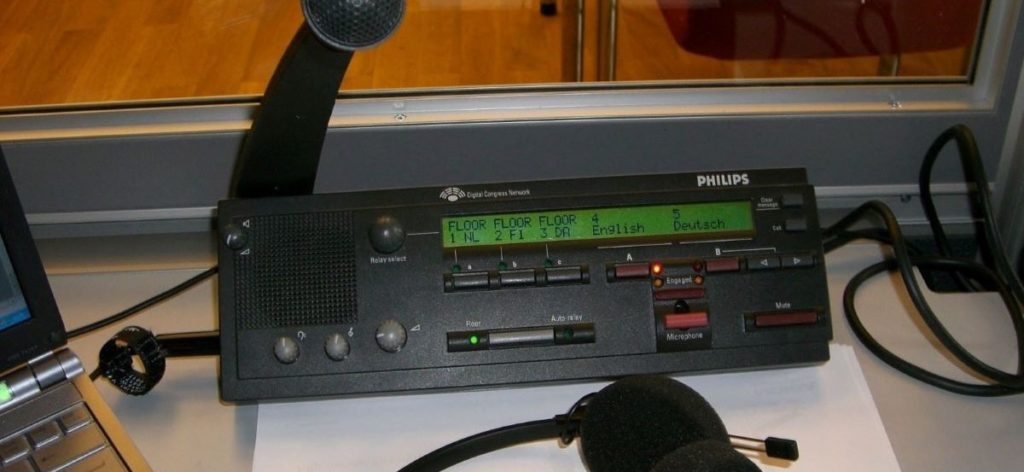Synchronous interpretation, simultaneous translation or live interpretation – which is it?

Have you ever wondered about the precise difference between consecutive and simultaneous interpreting? Or even what the proper term is? Is it simultaneous translation or synchronous interpreting? We frequently encounter all sorts of imaginative descriptions of our job, such as:
- real-time interpretation, real-time translation
- live translation, live interpretation
- liaison interpreting, negotiations interpreting, conversation interpreting
- oral translation, spoken translation, spoken language translation, speech-to-speech translation
- booth interpreting
- parallel interpreting, parallel translation
- concurrent interpreting, concurrent translation
- simultaneous translation
- extemporaneous translation
- synchronous interpreting, synchronous translation
While the multitude of terms can be cause for confusion, it’s actually quite simple: When professionals speak of translation, they are referring only to written language. In contrast, the verbal rendering of one language into another is properly called interpreting. And when the interpreter and the presenter speak at the same time, this is known as simultaneous interpreting.
What is simultaneous interpreting?
Simultaneous interpreting involves (nearly) synchronously verbally rendering one spoken language into another while the presenter is speaking. And how is it that the interpreter can speak at the same time as the presenter? Can interpreters read minds? No. Strictly speaking, interpretation occurs with a slight delay, known as décalage (French for delay), and interpreters are simply very well-practised at recognising sentence structures and predicting how a sentence will end.
But why is this called simultaneous rather than synchronous interpreting? Isn’t it the same thing? Not quite. Calling the practice simultaneous actually doesn’t refer to the temporal aspect of interpreting, but rather to the fact that interpreters perform multiple tasks at once: listening, understanding, translating and speaking. If you can remember back in your school days how difficult it was to listen and comprehend what your teacher was saying, while also holding a conversation with a classmate, you might have an inkling of what it’s like. But unlike pupils, simultaneous interpreters can’t afford to lose focus for even a fraction of a second. Intense concentration is needed, which is why simultaneous interpreters always work in teams and switch off every 20 to 30 minutes.
Simultaneous interpreters are in high demand for longer events that are held in more than two languages. They work in teams of two or three in soundproof booths, which allows them to hear the speaker without any distracting background noise. The interpretation is then spoken into a microphone and broadcast live to the listeners’ headphones.
If interpreting booths aren’t available – be it on account of a lack of space or because the interpreting is taking place at an outdoor event or a function such as a factory tour or company visit, where participants are often on the move – tour guide systems can be used.
The difference between simultaneous and consecutive interpreting

While the interpreter and speaker speak at nearly the same time in simultaneous interpreting, consecutive interpreting involves a time delay. In other words, the interpreter waits until the speaker reaches a logical stopping point before beginning the interpretation. This means that the speaker and interpreter take turns speaking. To ensure that nothing is lost during longer segments, interpreters rely on a special note-taking technique.
Consecutive interpreting is suitable for shorter events of up to 1½ hours, such as press conferences or short presentations. In contrast to simultaneous interpreting, technical equipment is not typically needed. But new technologies are also making it possible to provide consecutive interpreting services remotely. Remote interpreting utilises software such as Zoom or Microsoft Teams to provide consecutive interpretation of telephone conferences and video calls. Interpreting studios known as hubs even allow for simultaneous interpreting to be streamed over the internet.
For conversations, liaison interpreting is another option. In contrast to consecutive interpreting, liaison interpreting involves interpreting sentence-by-sentence into and out of each language (i.e. from French to English and then from English to French) and is also offered by language service providers who are not necessarily trained conference interpreters.
Whether consecutive or simultaneous – Peschel Communications would be happy to consult with you personally to determine which mode of interpreting is right for your location and event. We also welcome your questions on organising multilingual teams, arranging for interpreting equipment and identifying possible language combinations.